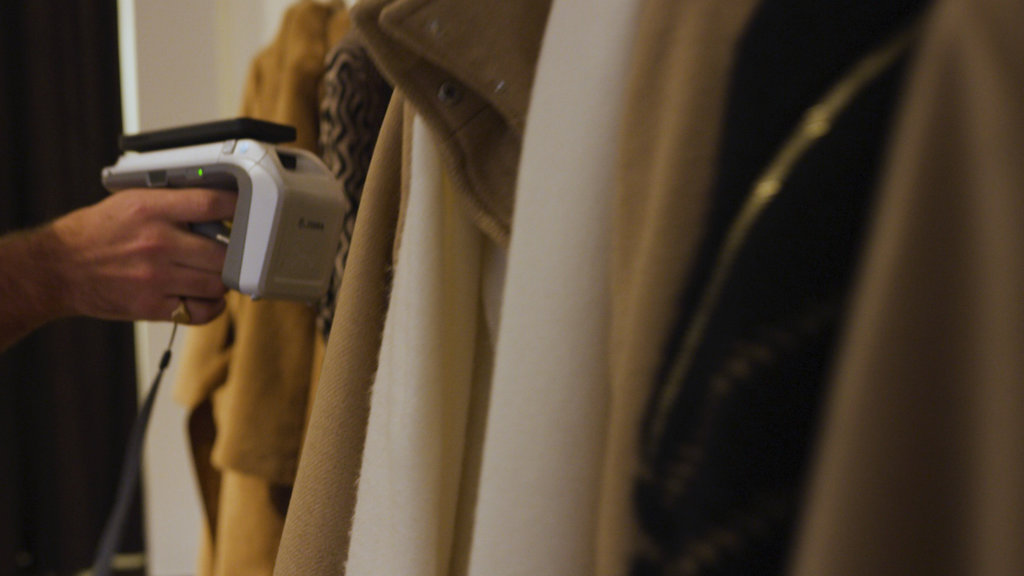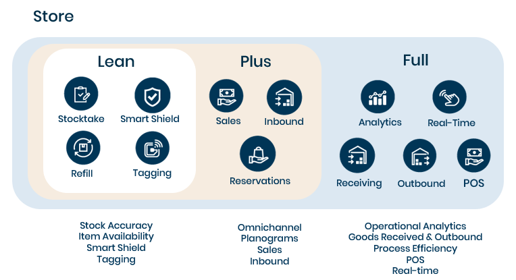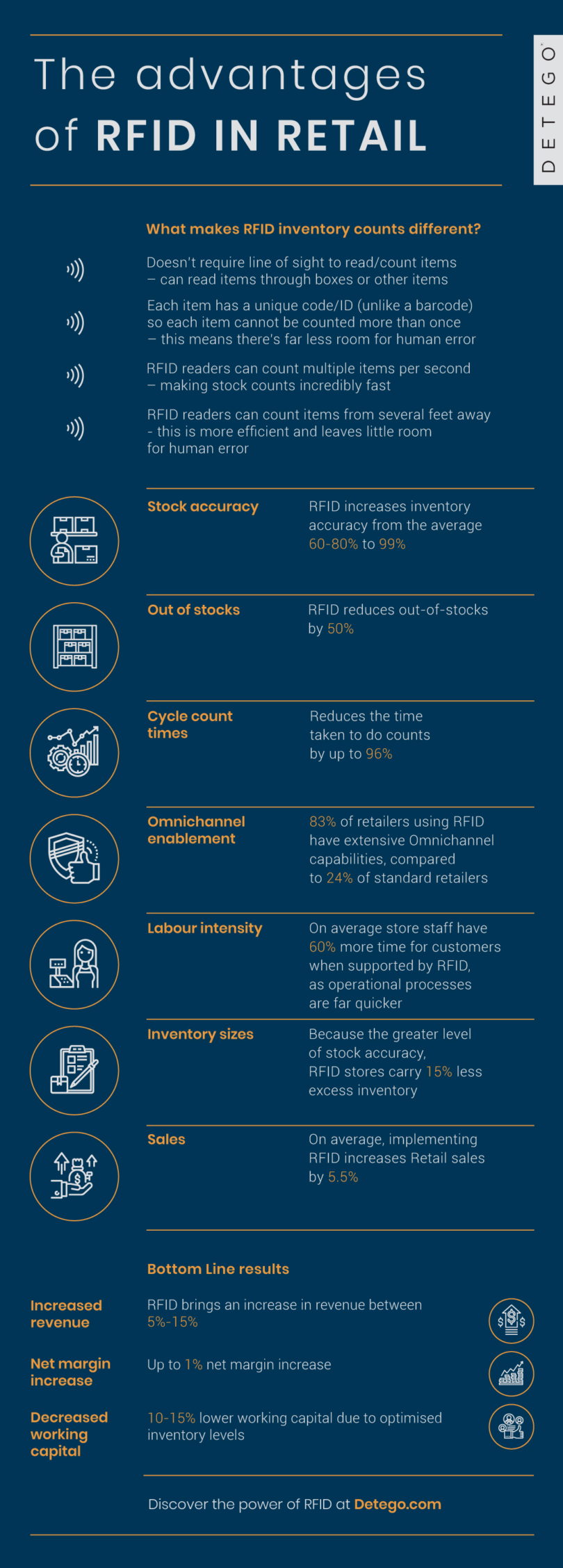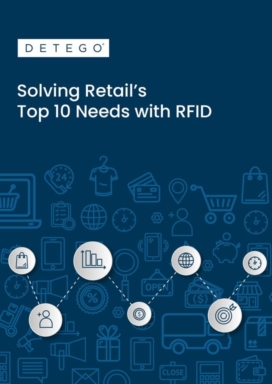Radio frequency identification (RFID) has had a fairly long road to adoption in the retail industry. Leading the way on this journey has often been large tier 1 retailers, either investing and experimenting with the technology in-house or partnering with early RFID specialists like Detego.
However, in the more settled retail RFID industry of today, implementing the technology is a different prospect. Here’s 4 reasons why there’s never been a better time for small and medium retailers to reap the benefits of RFID:
1) RFID has Lowered in Cost
Naturally, price point is a huge factor in choosing to implement a new technology for retailers of any size. Like most technologies, RFID was at its most expensive when it was new, but over time has become more and more affordable. This drop in cost is mostly down to the price of RFID tags themselves decreasing significantly. In the early 2000s, tags cost up to $0.75 (Approx. £0.50) whereas these days the average cost is between 3 to 8 cents (so around £0.05).
Developments in hardware and software also make a difference to the price point of RFID projects. For small and medium sized retailers, in particular, the need for only a single handheld reader per store, new hardware like mobile RFID label printers, and the availability of modular cloud-based SaaS solutions can lower the initial investment required to get started with the technology. This combination of industry progress makes leaner, more affordable RFID solutions a reality.

2) The Established RFID Industry Presents Less Risk and Better Knowledge Application
In the early days, RFID projects presented something of a risk. Bigger brands have the resources and personnel for (often in-house) ‘trial and error’ projects, but smaller organisations do not. Now that Retail RFID is an established sub-industry, retailers no longer have to go it alone and have far more options in terms of vendors, partners and solutions. This often means no steep learning curves and more stable and effective digital transformations. In other words, it’s now known what works and what doesn’t work for RFID in the retail industry.
How has RFID become more feasible for retailers over time?
- Expanded and established use cases
- Project stability
- Securing return of investment
- Easy and less expensive implementation
3) RFID Implementation has Become Easier
Historically, implementation has always been a barrier to entry for RFID. This is because adopting RFID is a fairly transformative project, meaning you have to make significant changes to see the significant benefits. Unfortunately, these changes have looked too daunting for many a retailer, especially for smaller brands who don’t have the resources to spare on long projects or clunky transformations. In recent years however, established RFID solutions offer more of a ‘plug and play’ experience.
How has RFID implementation changed for retailers?
- Out-of-the-box solutions
- Cloud-hosted platforms
- Smart shield
- Able to print and encode labels on-site
4) Scalable Solutions are the Perfect Platform for Smaller Retailers to Unlock the Value of RFID
As well as easier implementation, scalable SaaS solutions are now common practise, making RFID projects easier to manage and develop over time. A scalable solution means retailers don’t have to jump straight into the deep end. This makes the technology far more accessible for retailers of all sizes, but perhaps particularly for smaller sized retailer who have a limited technology budget and need to invest over time.
Scalable solutions, like the Detego platform, often focus on core deliverable KPI’s like inventory accuracy and product availability in stores. This is because they provide immediate ROI as well as being the key foundation for many of RFID’s other use cases. One of the main benefits of scalable RFID for smaller retailers is the quickly established ROI can fund the additional investment needed to scale the solution, providing a much easier route to full adoption.
Here’s an example of what a scalable in-store RFID solution (The Detego Store platform) looks like:

Putting It All Together – What an RFID Project Should look Like for a Smaller Retailer.
So, a smaller retailer can take advantage of RFID with only a single handheld reader per store and a lean cloud-hosted RFID solution run through a mobile application. Other than the initial change in production to introduce source-tagging (adding RFID labels at the factory) implementation for such a solution is very minimal. The result of this would be rapid increase in stock accuracy, product availability and a subsequent increase in sales. This type of project provides an almost immediate return of investment, the retailer could then choose to scale and advance their solution at any point or stay with what they have and benefit from a leaner, better managed inventory.
Summary
Not only has the technology matured, including tags, hardware and software, but RFID use cases, best-practise and implantation strategies have now been firmly established. Additionally, the RFID sector is now an established market in its own right, meaning smaller enterprises don’t have to go it alone. By using established and experienced specialist partners, retailers can skip the learning curves and go straight to reaping the benefits of RFID.
Want the latest retail and retail tech insights directly to your inbox?

The retail environment has never been more demanding than it is today, thanks to fierce competition, the growth of e-commerce, and consumers’ high expectations for seamless shopping experiences. It’s a situation made even more difficult by a lack of inventory visibility, the complexity of supply chains and the sheer variety of products brands are faced with.
While retailers have access to a growing number of solutions to these issues, RFID (Radio Frequency Identification) is the only one that’s proven to consistently meet retailers’ needs for leaner processes, accurate inventory and real-time data analytics.
This webinar covers:
• The five most important needs identified by retailers and their effect on business
• How RFID-based systems and processes can be applied to solve each need
• What financial and operational benefits can be gained by doing so
• How retailers can further unlock the power of RFID to offer a truly seamless and connected shopping experience
The 6 Key Benefits of RFID in Retail
RFID (Radio Frequency Identification) uses radio waves to track and identify tags attached to objects. The tags contain electronically stored information and are counted or ‘read’ by either handheld or fixed RFID readers.
In many ways RFID is used in retail as an alternative to a barcode system (although it doesn’t have to replace barcodes entirely). The more advanced technology involved in RFID mean it has a far greater level of accuracy and efficiency when it comes to counting inventory. As a result of this it has far broader applications in retail, most of which are built of off the back of this reliable inventory visibility.
By implementing RFID retailers can on average increase their revenue from 5-15% depending on the business. This on top of a margin increase of up to 1% and 10-15% lower working capital due to optimised inventory levels.
According to research in 2018, 69% of retailers cite a significant level of adoption, and this number is continuing to rise.

eBook
Solving Retail's Top 10 Needs with RFID
Discover how retail RFID is changing the industry for good. This eBook will guide you through the top 10 needs identified by retailers to ensure sustainable success in the modern environment. Explore the common challenges preventing retailers from achieving their goals and learn how applying smart RFID-based solutions delivers consistently good results.
Inventory Visibility

Due to the ease and accuracy of RFID stock counts, retailers using the technology can reliably achieve full item-level inventory visibility across their stores and supply chains. Crucially, due to the speed of RFID inventory counts, this can be achieved whilst actively reducing the labour intensity of operational processes. This accurate and up-to-the-minute inventory information is the backbone of so many of RFID’s uses in retail (including many of the points discussed below).
One crucial aspect of modern retail that relies on having accurate inventory visibility is Omnichannel retailing. With a complete and up-to-date view of stock across all channels, it is possible to open up the inventory of your entire store network to customers, providing a better customer experience and increasing sales.
Benefits of item-level inventory visibility
- Improved shipping accuracy
- Excellent baseline for advanced omnichannel retailing
- Produces more data for better insights
- Reduces inventory size (and therefore working capital) significantly
- Increased customer satisfaction from reduced out-of-stocks and a more connected experience
Increasing Product Availability

Ensuring a high product availability is vital to maintaining retail sales. Despite this, low on-floor product availability and out-of-stocks are an alarmingly common problem in the industry, causing unnecessary lost sales as a result of inefficient replenishment processes and stock inaccuracy. This latter cause is practically removed completely by RFID, with typical stock accuracy being increased to 99% from the standard 60-80%.
Additionally, RFID platforms provide an unbeatable basis for efficient and reliable replenishment processes. The main advantage these platforms have is the item-level and real-time inventory visibility gained from regular 99% accuracy stock counts.
How does RFID increase product availability?
- Makes regular cycle counts possible with efficient RFID stock reads
- Removes stock inaccuracy (from 70-80% to 99%)
- Creates complete item-level view of stock between both backroom and sales floor
- Item visibility makes replenishment easier and more accurate
- Real-time view allows for replenishment alerts for when items/sizes are running low
- Item-level data from RFID allows for advanced, even AI-assisted planograms for individual stores
Supply Chain Traceability

We’ve discussed the difference item-level visibility makes for stores, but when it comes to supply chains the benefits are just as great. With RFID, inbound and outbound reads become far easier, and are done on an individual item level rather than SKU (stock keeping unit). This means each item is accounted for at each step of the supply chain, rather than just shipments or boxes.
This level of stock visibility also drastically reduces the rate of shipping errors or picking mistakes as they are detected by RFID readers and corrected by warehouse staff during exception handling or outbound reads.
Additionally, the location or status of items and shipments are visible in real-time, so stores and DC’s can easily track shipments and know exactly what they will be receiving. This makes any individual item fully traceable, as time and dates of when the item passed each read point in the supply process can be stored.
Benefits of RFID in the supply chain:
- Item-level visibility across entire supply chain
- Trace items against individual shipments
- Smoother operational processes
- Track shipments for delivery
- 100% inbound and outbound shipping accuracy
Increasing Process Efficiency

The difference in process efficiency from using RFID in retail is extensive, at every end of retail, be it the factory or the shop floor. An RFID reader, regardless of whether its fixed or a handheld, can read hundreds of individual items at once. Crucially though, as each item has a unique ID, they can never be read more than once. The signals also do not require line of sight to be read.
Naturally, this makes RFID inventory counts and inbound/outbound checks incredibly fast and reliable. In the case of store inventories, RFID has been found to reduce cycle count times by a staggering 96%. This therefore means they are far more convenient to perform and can be done multiple times in a week rather than a year.
Processes transformed by RFID:
- Cycle counts/inventories
- Fast & Efficient Inbound & Outbound reads
- RFID-enabled picking and packing
- Mobile guided replenishment from backroom to salesfloor
Providing Real-Time Data

Analytics and data is one area that e-commerce is ahead of physical retail. This is largely due to the fact that everything online can be measured, whereas retailers don’t really know what’s happening with their stores and customers in any specific detail, and the stats and data they do collect are often historical and at risk of being outdated.
However, with RFID this can all change. The simplest and most effective use of the data allows retailers to better leverage their greatest assets; their products and their stores. Quality data and analytics can allow retailers to ensure merchandise is in the right place to be sold. Information on which stores are performing better or worse is a basic retail KPI, but with specific item data, RFID produces far more detailed insights. This includes how well individual items are doing in specific stores, right down to specifics such as which sizes of items are selling better where. Insights such as these are naturally actionable, meaning retailers can take steps to move or reinforce stock at specific stores.
Data insights and results possible with RFID:
- KPI based performance tracking
- Detailed merchandise data & Analytics
- Operational excellence
- Actionable recommendations
- Compliance tracking
- Eliminates reliance on historical data
- Predictive capabilities for inventory counts and merchandise management
Transforming Customer Experience

There are many effects of RFID in retail that go beyond simple operational benefits to actively improve the customer experience. At the most basic level, this includes things already mentioned like increasing product availability, offering convenient omnichannel services and freeing up store associates to spend more time assisting customers.
However, because of the real-time inventory visibility it provides, RFID can go way beyond this in terms of improving the customer experience. For example, with reliable and up-to-the-minute stock information stores can utilise technologies like chatbots or smart fitting rooms to assist customers with their queries, supply information about other items or sizes available and even cross-sell to customers in the store.
What ways does RFID improve the customer experience?
- High product availability
- Store associates have more time for their customers
- Convenient omnichannel services
- A connected experience between online and offline
- AI-powered chatbots delivering assistance and product information via mobile.
- Smart fitting rooms providing a hugely improved fitting room experience.
- RFID-enabled Point of Sale – including self-checkout services

eBook
Solving Retail's Top 10 Needs with RFID
Discover how retail RFID is changing the industry for good. This eBook will guide you through the top 10 needs identified by retailers to ensure sustainable success in the modern environment. Explore the common challenges preventing retailers from achieving their goals and learn how applying smart RFID-based solutions delivers consistently good results.
The age of digital disruption has caused a shift in both consumer expectations and the retail landscape as a whole. Naturally, many retailers have looked towards implementing new technologies in an attempt to either adapt to or capitalise on these changes. When researching new retail technologies, the focus should be on transforming the customer’s experience and eliminating existing friction points.
The question needs to be asked, is this directly solving a major problem for retail customers? In other words: Is there a demand for it? Focusing on the comparatively mundane details first needs to be a priority, as attention on what drives customer experience at the most basic level can be the difference between success and failure in the age of digital disruption.
One technology that consistently meets these demands is radio Frequency identification. RFID is a growing force in retail, with 69% of retailers around the world citing a significant level of RFID adoption. The technology involves tagging individual items of merchandise, like a barcode but entirely unique to the individual item that can be ‘read’ and tracked with ease. One of the most common business cases for the technology is the process accuracy and efficiency that it delivers, but the difference that RFID can make to the customer is not to be overlooked.
Out-of-stock situations
Empty shelves are a simple problem, and yet are still a painfully common occurrence in retail. In a survey by Elastic Path, it was found that 55% of shoppers surveyed had experienced an issue with out of stock inventory. Is it then any wonder then that ecommerce is putting pressure on brick-and-mortar stores?
As obvious as it might sound, a product can only be bought if it’s on the shop-floor. If replenishment isn’t automated or falls victim to human error, stores can be temporarily faced with unnecessary out of stock situations that damage both sales and reputation. This problem is often a subtle one, with stores and retailers having no way of observing the true level of item availability.
With a cloud-based RFID platform that utilises the Internet of Things, on-floor availability becomes much easier to manage, significantly reducing out-of-stock situations by up to 50%. The main way this is achieved is through fast and accurate stocktakes and automated replenishment processes. Store staff can now perform stock takes of an entire store (50,000 items) in just 25 minutes to a level of 99% accuracy.
This full and accurate view of store stock combats out-of-stocks in two ways. Firstly, the visibility of stock provides store staff to easily monitor stock levels. More advanced RFID systems like the Detego platform can not only operate in real-time and provide replenishment alerts, but can they can also use machine learning to suggest optimised replenishment advice, set on either a set planogram or an AI-optimised one.
Disconnect between online & offline
The increasing influence of online and ecommerce is arguably the biggest driver of digital disruption in retail. The convenience and choice that shopping online offers has resulted in highly demanding modern customers. Whilst these days practically every brick-and-mortar retailer has expanded into e-commerce to meet these consumer demands, there is unfortunately a noticeable disconnect between many retailer’s online and offline shopping channels, damaging the customer experience despite best intentions.
The key to a good ‘omnichannel’ shopping experience is not to necessarily be everywhere, but to be seamless and flexible at every step of the shopping journey. Non pure-play retailers that can do this will have a competitive advantage, not least because of the choice they offer customers, but with features like click-and-collect and ship-from-store, they can offer an unmatchable level of flexibility whilst opening up the entire inventory network to all channels.
To be able to do this, retailers need a complete and real-time view of stock across their store network in all channels. RFID provides this through digitising stock (utilising the IoT) and tracing the movement of individual items in real-time. With this foundation, it is possible to build extensive and reliable omnichannel services, blending shopping channels and providing a flexible and convenient experience for customers. RFID is the backbone of strong omnichannel services such as this. In fact, 83% of RFID adopters offer three or more omnichannel fulfilment options compared to only 24% of non-adopters.
At its most basic level, this can include opening up stock transparency to customers so they can check availability of items online before coming into a store. The more advanced features include click-and-collect and ship-from-store, both of which provide a competitive edge against pure-play ecommerce, as customers get a more convenient and flexible shopping experience regardless of which ‘channels’ they use.
Limited Customer service
When discussing disruption and new technologies, its easy to forget about core principles and traditional strengths, but technology should be built with those in mind. For retail stores, that means customer service. This remains a key part of physical stores’ USP today, but with the demand for store associates’ time being severe, these traditional strengths can sometimes be left behind.
In studies by Elastic path it was found that 42% of shoppers surveyed said they’d had an issue with long wait times for customer service, suggesting that something new is required to stop what was once a core strength of stores becoming a friction point for customers.
RFID platforms meet this demand in two different ways. First and foremost, is simply the fact that RFID operations are much leaner and less labour intensive, for example it cuts cycle count times by up to 96%. This has the simple yet effective result of drastically decreasing the amount of time retail staff have to spend on manual processes like replenishment, therefore freeing up a significant amount of staff time to be spent elsewhere with customers.
The other significant ways RFID can assist customer service are the platforms and features that can be built around the technology. Mobile chatbots can assist customers with queries about item availability and available sizes, thanks to the real-time item transparency produced by RFID. In the fashion industry, Smart-Mirrors can do this whilst also reducing the friction points associated with changing rooms, as they can provide information from within the fitting room and can also be fitted with features to call store assistants to bring any items required to the fitting room.
Fashion Retail and RFID are a perfect fit which is proved by many major fashion retail chains that have already moved to in-store RFID with excellent results. RFID makes it possible to easily identify articles and have full merchandise visibility. Successful fashion retailers go one step further and use more of the hidden potential behind real-time article transparency, laying the foundation for overcoming their greatest strategic challenges, among them omni-channel and digitalisation.
This webinar provides insights how international fashion retailers are laying the right foundation for their successful strategies, and how they use RFID as a base to differentiate in the extremely competitive segment of fashion retail.



